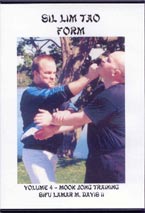
 |

HISTORY & DEVELOPMENT
 There
are many stages in the development of Bruce Lee’s fighting
art. Most people say three. I prefer to say four! I look at the five
years of wing chun gung fu training that Bruce Lee had in Hong Kong
as being extremely important to his development. The other three
stages can be defined as the Seattle period, the Oakland period and
the L. A. Chinatown period.
There
are many stages in the development of Bruce Lee’s fighting
art. Most people say three. I prefer to say four! I look at the five
years of wing chun gung fu training that Bruce Lee had in Hong Kong
as being extremely important to his development. The other three
stages can be defined as the Seattle period, the Oakland period and
the L. A. Chinatown period.
Wing chun gung fu was, and is, a very important part of Bruce Lee’s fighting method. Many practitioners of Jeet Kune Do today tend to downplay the importance of wing chun, saying that Bruce Lee had almost completely discarded wing chun toward the end. I feel that they do this because that is the easy way out! By continuing to downplay the importance of wing chun, they cleverly avoid having to actually get in there and learn what wing chun is all about!
Patrick Strong, one of Bruce Lee’s original students from the Seattle period, and a close personal friend of mine, told me that Bruce Lee practiced sil lim tao, the first wing chun form, at least five to eight times every day! He knew that this form was important to his structure. It strengthens your foundation and economizes all of your movements. Although you may not see the sil lim tao form when you see Bruce Lee move, that doesn’t mean that all of the benefits gained from it’s practice are not there!
 After
over twenty years of training in Bruce Lee’s art, I found
that going back to wing chun, back to the roots of the art, did
wonders for strengthening
my structure! Now I am practicing the sil lim tao form a minimum of five times
per day! I have found that most of Bruce Lee’s students who are highly
proficient in his art have gone through this same process of re-discovering
their roots. Wing chun gung fu training greatly strengthens your structure!
Anyone
who tells you differently is just not with it! It’s just that simple!
After
over twenty years of training in Bruce Lee’s art, I found
that going back to wing chun, back to the roots of the art, did
wonders for strengthening
my structure! Now I am practicing the sil lim tao form a minimum of five times
per day! I have found that most of Bruce Lee’s students who are highly
proficient in his art have gone through this same process of re-discovering
their roots. Wing chun gung fu training greatly strengthens your structure!
Anyone
who tells you differently is just not with it! It’s just that simple!
Bruce Lee’s wing chun gung fu training came directly from Yip Man, who at the time was the Grandmaster of the system, and two of his most prominent disciples, Wong Shun Leung and Cheung Chuk Heng (William Cheung). It is a known fact that although Bruce Lee did not learn the entire system before leaving for the United States, he learned more than enough to draw the most important benefits from the training! The bottom line is this, wing chun gung fu does indeed form the foundation, or nucleus, of the Jeet Kune Do method of fighting!
Bruce Lee’s first school in the United States was in Seattle, Washington. There he taught what was then referred to as Jun Fan Gung Fu, which was a modified form of wing chun. Bruce Lee’s Chinese name was Lee Jun Fan, thus Jun Fan Gung Fu essentially meant Bruce Lee’s Gung Fu! His first student and assistant instructor there was a man named Jesse Glover. Jesse still teaches today, and calls his approach non-classical gung fu.
 When classes got larger and Bruce
Lee opened a formal school, Jesse chose to just continue training with
a few friends rather than be a part of the
school,
continuing to sharpen the techniques that he had learned from training
with Bruce. Bruce Lee’s assistant instructor at the Jun Fan Gung
Fu Institute was a man named Taky Kimura. Taky continues to operate the
Jun Fan Gung Fu
Institute
today in Seattle. He is a big part of the organization known as the Bruce
Lee Foundation and he works hard to do his part to preserve the original
teachings
of Bruce Lee.
When classes got larger and Bruce
Lee opened a formal school, Jesse chose to just continue training with
a few friends rather than be a part of the
school,
continuing to sharpen the techniques that he had learned from training
with Bruce. Bruce Lee’s assistant instructor at the Jun Fan Gung
Fu Institute was a man named Taky Kimura. Taky continues to operate the
Jun Fan Gung Fu
Institute
today in Seattle. He is a big part of the organization known as the Bruce
Lee Foundation and he works hard to do his part to preserve the original
teachings
of Bruce Lee.
From Seattle, Bruce Lee moved to Oakland and opened the second Jun Fan
Gung Fu Institute there. His assistant there was a man named James Yimm
Lee.
Apparently the Chinese martial arts community there had a problem with Bruce Lee accepting the “gwai lo”, or foreign devils, as students! They sent one of their fighters, a young sifu named Wong Jak Man, to challenge Bruce Lee. If Bruce Lee lost the fight, he would no longer teach non-Chinese. If he won the fight, he would earn the right to teach whomever he pleased without further conflict.
 Although Bruce won the fight, it did not go as well for him
as he would have liked! His opponent’s style somewhat nullified
the effectiveness of his wing chun techniques. He felt that it had
taken him too long to finish the
fight and he was far too winded when it was over. He felt that his
stubborn adherence
to the wing chun style had hindered his effectiveness in the fight.
This forced him to go back and re-think his methods, as well as become
more involved in
physical training. This was the planting of the early seeds that
would become Jeet Kune
Do.
Although Bruce won the fight, it did not go as well for him
as he would have liked! His opponent’s style somewhat nullified
the effectiveness of his wing chun techniques. He felt that it had
taken him too long to finish the
fight and he was far too winded when it was over. He felt that his
stubborn adherence
to the wing chun style had hindered his effectiveness in the fight.
This forced him to go back and re-think his methods, as well as become
more involved in
physical training. This was the planting of the early seeds that
would become Jeet Kune
Do.
In an early letter to one of his students, Bruce Lee described
a new method of fighting that he was developing. He stated that
it would
consist of
techniques from wing chun gung fu, boxing and fencing. He also
stated that this new
art would be “it”! This “it” became Jeet
Kune Do, the Way of the Intercepting Fist.
Bruce Lee’s last Jun Fan Gung Fu Institute was in Los Angeles,
California. The location was 628 College Street, in L. A. Chinatown.
Bruce Lee’s
assistant instructor at this kwoon was Daniel Inosanto. It was
here that Jeet Kune Do further
developed and flourished. Bruce Lee continued to update Taky Kimura
and James Yimm Lee on the developments of his art.
When Bruce Lee got more involved in acting and movie making, he decided to close all of his schools. Rather than have a formal school, he told the students to just get together for informal workouts and training sessions. Unfortunately, James Yimm Lee passed away about six months before Bruce Lee, and the Oakland group dispersed. Taky Kimura continued to teach in the basement of his grocery store in Seattle and Dan Inosanto taught a small group in his back yard.
 On July 20th, 1973, the world’s greatest
martial artist passed away at the age of thirty-two! His students
did not know what to do at that point.
Their guiding flame had burned out! Although they almost gave up,
Taky Kimura continued
teaching in the basement of his store in Seattle and Dan Inosanto,
along with Richard Bustillo (another L. A. Chinatown student),
opened a school called
the Filipino Kali Academy in Torrance, California. Taky Kimura
continued to teach
Jun Fan Gung Fu and Dan Inosanto taught both Jeet Kune Do and the
Filipino martial arts.
On July 20th, 1973, the world’s greatest
martial artist passed away at the age of thirty-two! His students
did not know what to do at that point.
Their guiding flame had burned out! Although they almost gave up,
Taky Kimura continued
teaching in the basement of his store in Seattle and Dan Inosanto,
along with Richard Bustillo (another L. A. Chinatown student),
opened a school called
the Filipino Kali Academy in Torrance, California. Taky Kimura
continued to teach
Jun Fan Gung Fu and Dan Inosanto taught both Jeet Kune Do and the
Filipino martial arts.
Today there are several different versions, or approaches to Jeet Kune Do, all claiming to be legitimate and all claiming to be what Bruce Lee would have wanted! One group is referred to as Jun Fan Jeet Kune Do. This group prefers to continue practicing the art as it was developed, practiced and taught by Bruce Lee. Another group is referred to as Jeet Kune Do concepts. This group, led by Dan Inosanto, trains in many different martial arts, applying Bruce Lee’s principles to the training. Our group, known as Hardcore Jeet Kune Do, practices the original teachings of Bruce Lee, but in our own unique way. Then there are other lesser known groups, each claiming to be legitimate versions of Jeet Kune Do. The bottom line here is this, the further away you get from the three earlier mentioned groups, the less legitimate you are and the further away from Bruce Lee’s original teachings you get!
Copyright © 2005 Lamar M. Davis
II. All Rights Reserved.
A Webspace Enterprises, Inc. Creation™

